Related Research Articles

Canadian football, or simply football, is a sport in Canada in which two teams of 12 players each compete on a field 110 yards (101 m) long and 65 yards (59 m) wide, attempting to advance a pointed oval-shaped ball into the opposing team's end zone.
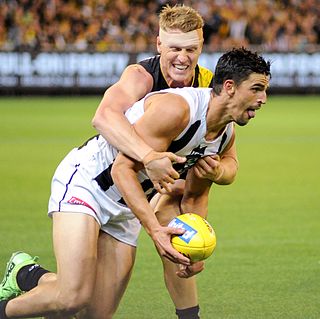
Most forms of football have a move known as a tackle. The primary purposes of tackling are to dispossess an opponent of the ball, to stop the player from gaining ground towards goal or to stop them from carrying out what they intend.

In many team sports that involve scoring goals, the goalkeeper is a designated player charged with directly preventing the opposing team from scoring by blocking or intercepting opposing shots on goal. Such positions exist in bandy, rink bandy, camogie, association football, Gaelic football, international rules football, floorball, handball, hurling, field hockey, ice hockey, roller hockey, lacrosse, ringette, rinkball, water polo, and shinty, as well as in other sports.

A touchdown is a scoring play in gridiron football. Scoring a touchdown grants the team that scored it 6 points. Whether running, passing, returning a kickoff or punt, or recovering a turnover, a team scores a touchdown by advancing the football into the opponent's end zone. More specifically, a touchdown is when a player is in possession of the ball, any part of the ball is in the end zone they are attacking, and the player is not down.
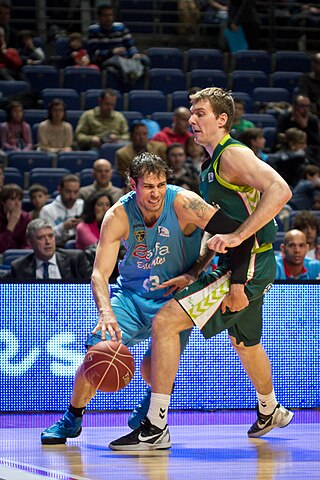
In basketball, a personal foul is a breach of the rules that concerns illegal personal contact with an opponent. It is the most common type of foul in basketball. A player fouls out on reaching a limit on personal fouls for the game and is disqualified from participation in the remainder of the game.
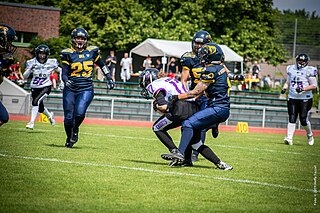
American and Canadian football are gridiron codes of football that are very similar; both have their origins partly in rugby football, but some key differences exist between the two codes.

Gameplay in American football consists of a series of downs, individual plays of short duration, outside of which the ball is or is not in play. These can be plays from scrimmage – passes, runs, punts or field goal attempts – or free kicks such as kickoffs and fair catch kicks. Substitutions can be made between downs, which allows for a great deal of specialization as coaches choose the players best suited for each particular situation. During a play, each team should have no more than 11 players on the field, and each of them has specific tasks assigned for that specific play.

A kickoff is a method of starting a drive in gridiron football. Additionally, it may refer to a kickoff time, the scheduled time of the first kickoff of a game. Typically, a kickoff consists of one team – the "kicking team" – kicking the ball to the opposing team – the "receiving team". The receiving team is then entitled to return the ball, i.e., attempt to advance it towards the kicking team's end zone, until the player with the ball is tackled by the kicking team, goes out of bounds, scores a touchdown, or the play is otherwise ruled dead. Kickoffs take place at the start of each half of play, the beginning of overtime in some overtime formats, and after scoring plays.

A comparison of American football and rugby union is possible because of the games' shared origins, despite their dissimilarities.
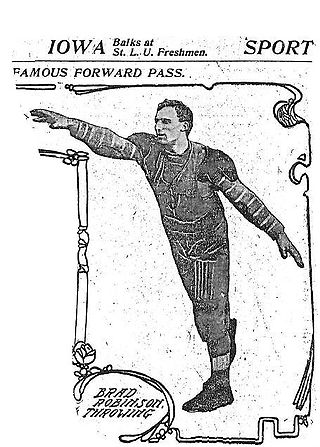
In gridiron football, a triple-threat man is a player who excels at all three of the skills of running, passing, and kicking. In modern usage, such a player would be referred to as a utility player.

A field goal (FG) is a means of scoring in gridiron football. To score a field goal, the team in possession of the ball must place kick, or drop kick, the ball through the goal, i.e., between the uprights and over the crossbar. The entire ball must pass through the vertical plane of the goal, which is the area above the crossbar and between the uprights or, if above the uprights, between their outside edges. American football requires that a field goal must only come during a play from scrimmage while Canadian football retains open field kicks and thus field goals may be scored at any time from anywhere on the field and by any player. The vast majority of field goals, in both codes, are placekicked. Drop-kicked field goals were common in the early days of gridiron football but are almost never attempted in modern times. A field goal may also be scored through a fair catch kick, but this is also extremely rare. In most leagues, a successful field goal awards three points.

A fullback (FB) is a position in the offensive backfield in gridiron football and is one of the two running back positions along with the halfback. Fullbacks are typically larger than halfbacks, and, in most offensive schemes, the fullback's duties are split among power running, pass catching, and blocking for both the quarterback and the other running back.
The following terms are used in American football, both conventional and indoor. Some of these terms are also in use in Canadian football; for a list of terms unique to that code, see Glossary of Canadian football.
In gridiron football, roughing the passer is a foul in which a defensive player makes illegal contact with the quarterback after the latter has thrown a forward pass. The penalty is 10 or 15 yards, depending on the league, an automatic first down for the offense, and a disqualification if flagrant. Defenders are allowed to contact a player attempting a forward pass while he still has possession of the ball ; however, once the ball is released, defenders are not allowed to make contact with the quarterback unless carried to do so by momentum. Judgment over whether contact following release was the result of a violation or momentum is made by the referee on a case-by-case basis.

In gridiron football, a penalty is a sanction assessed against a team for a violation of the rules, called a foul. Officials initially signal penalties by tossing a bright yellow colored penalty flag onto the field toward or at the spot of a foul.
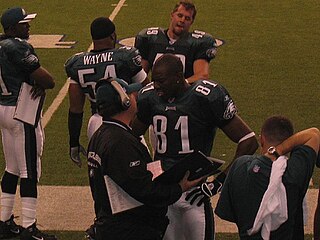
In sports, out of bounds refers to being outside the playing boundaries of the field. The legality of going out of bounds, and the ease of prevention, vary by sport. Sports that use this term include American football, Canadian football, field lacrosse, basketball, rugby union, rugby league, and association football.
In gridiron football, blocking below the waist is an illegal block, from any direction, below the waist by any defensive player or by an offensive player under certain situations, by any player after change of possession, with certain exceptions. It is sometimes incorrectly referred to as a "chop block". Such blocks are banned due to the risk of injury, particularly those to the knee and ankle. The penalty for a block below the waist is 15 yards in the NFL, NCAA, and in high school. The block is illegal unless it is against the ball carrier.

In gridiron football, a punt is a kick performed by dropping the ball from the hands and then kicking the ball before it hits the ground. The most common use of this tactic is to punt the ball downfield to the opposing team, usually on the final down, with the hope of giving the receiving team a field position that is more advantageous to the kicking team when possession changes. The result of a typical punt, barring any penalties or extraordinary circumstances, is a first down for the receiving team. A punt is not to be confused with a drop kick, a kick after the ball hits the ground, now rare in both American and Canadian football.
In gridiron football, clipping is the act of a "throwing the body across the back of the leg of an eligible receiver or charging or falling into the back of an opponent below the waist after approaching him from behind, provided the opponent is not a runner." It is also clipping to roll up on the legs of an opponent after a block. It is usually illegal, but in the National Football League it is legal to clip above the knee in close-line play. The Canadian Football League has similar definitions, prohibitions and exceptions, including that "application of [a] penalty is determined by the initial contact".
References
- ↑ Nelson, David (1994). The anatomy of a game: football, the rules, and the men who made the game. University of Delaware Press. p. 520. ISBN 9780874134551.
- ↑ NFL Rule book, Article 9, Rule 12, Section 2
- ↑ Nelson, David (1994). The anatomy of a game: football, the rules, and the men who made the game. University of Delaware Press. p. 515. ISBN 9780874134551.
- 1 2 Nelson, David (1994). The anatomy of a game: football, the rules, and the men who made the game. University of Delaware Press. p. 476. ISBN 9780874134551.